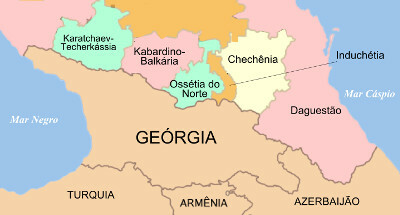Russia is one of the most obvious examples of the gap between the construction of borders policies represented by the sovereignty of States and the different nations that make up these places. Thus, this country - as well as the other States of the Commonwealth of Independent States (CIS) - shelters in its regions that are true ethnic mosaics that, in many cases, seek to establish their own autonomy and independence.
In some cases, groups considered to be terrorists carried out numerous attacks and public threats against the Russian government, which in many cases severely repressed its opponents. On the eve of the 2014 Winter Olympics in Socchi, for example, an extremist group announced a video promising to carry out terrorist actions during what has been classified as "satanic games".
Many of the issues surrounding separatist groups in Russia and other former Soviet republics are primarily due to this pluralism in this region and, secondly, to the old posture of the government of Josef Stalin when implementing the so-called “politics of the blender". At this juncture, the Soviet administration forced the dispersion of different compositions throughout the territory belonging to the USSR, involving Uzbeks, Russians, Tajiks, Kazakhs, Kyrgyz and many others groups.
The Russian zone that presents hot spots is the region of Caucasus, a place that divides Eastern Europe and Western Asia, where a mountain range of the same name is situated, surrounded by the Black Sea and the Caspian Sea (see map below). The main republics that strive for independence in this region are Chechnya and Dagestan.

Map of the Caucasus, with Russian provinces to the north and neighboring countries to the south ²
At the beginning of the 21st century, the Russian government intensified measures to combat separatist groups. Most of the weight on this posture is attributed to the attacks of September 11, 2001 in the States United States, when terrorism became feared and seen internationally as a threat representative. Thus, groups previously considered extremist, violent or separatist, gained the label of terrorists, starting to be harshly repressed without further sanctions against the Russian government. However, this “anti-terror” posture was already practiced by local authorities.
As Russian repression intensified, extremist acts by rebel groups also increased. Among the most emblematic cases are the invasion of the Moscow Theater in 2002 and the attack on the Beslan school in 2004; in the first, the balance was the death of more than 150 hostages, while in the second, the number of victims was more than 300 dead.
THE Chechnya it has always been considered one of the places of greatest tension. The territory is considered an autonomous region, with a republic constituted, but still belonging to Russian territory. The Chechens – a predominantly Muslim nation – came to declare independence twice (in 1991 and 1994), but on both occasions. the cases did not have international recognition of their territory, in addition to having been harshly repressed by the government of Russia. Since the end of the USSR, several armed conflicts have taken place in the region.
O Dagestan, recently, took Chechnya the status of most dangerous region in Russia. Bomb attacks and conflict-related deaths are increasingly common. The presence of Islam is also a majority in this republic, which began to receive rebel incursions from 1999 onwards. To this day, attacks are frequent whose focus is mainly on political personalities and authorities.
In addition to involving the autonomous republics of Chechnya and Dagestan, political conflicts also affect other regions of the Caucasus, such as Ingushetia and North Ossetia. In the latter, there was even the aforementioned massacre at the Beslan school, which is also one of the main Russian bases for combating extremism. The Ossetians even accuse the Muslim Inghetti and the Chechens of promoting fundamentalist terrorism in their domains.
Chechnya's independence process seems to be far from happening, mainly due to the growing Russian domination and the legitimacy that the government's actions have taken internationally in the face of the rebels' image of terrorists. The region is strategically relevant for representing an outlet to the Caspian Sea and for containing some pipelines used to transport oil.
In addition to Chechnya and other Russian territories, there are also other separatist struggles in the Caucasus, such as in South Ossetia and Abkhazia, which seek independence from Georgia, as well as Nagorno Karabakh, an Armenian majority zone that seeks national liberation over the Azerbaijan.
___________________________
¹ Image Credits: NorthfoI'm / Shutterstock
² Image Credits: Kbh3rd / Wikimedia Commons
By Rodolfo Alves Pena
Graduated in Geography
Source: Brazil School - https://brasilescola.uol.com.br/geografia/russia-grupos-separatistas-no-caucaso.htm
